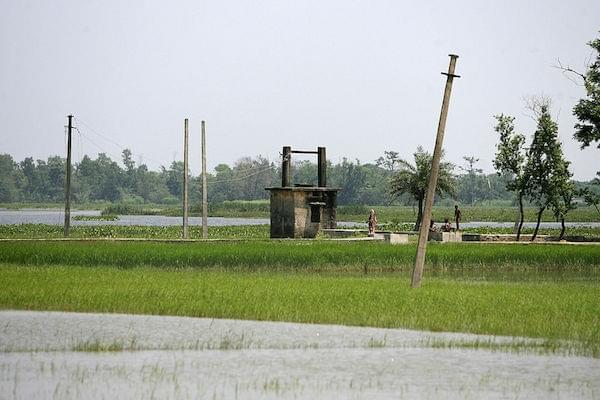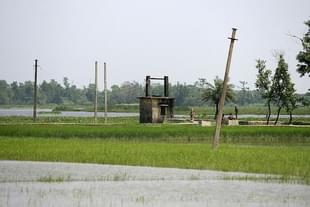Politics
Successive Droughts Causing A Revival Of Traditional Water Management Techniques
Aashish Chandorkar
Aug 03, 2016, 02:17 PM | Updated 02:16 PM IST
Save & read from anywhere!
Bookmark stories for easy access on any device or the Swarajya app.


Indian agriculture is heavily dependent on the monsoon rains, with nearly two third of the total area under cultivation not supported by credible irrigation facilities. While successive central and state governments have invested big sums of money on rural economy with focus on irrigation, agrarian problems do not seem to diminish at a rate fast enough. With nearly three fifths of Indian population dependent on agriculture which constitutes no more than a fifth of Indian gross domestic product (GDP), it is high time central and state governments seek to address rural stress on a permanent basis.
The current central government has defined an ambitious target of doubling Indian farmers’ income by the year 2022. While it is not clear whether the reference is to nominal or real income, the task itself is herculean either way. The central government has made provisions for various items linked to the agricultural sector, including improving irrigation facilities. The budget announced linking the spend on rural employment guarantee program MGNREGA to creation of productive assets like farm ponds, dug wells, and compost pits with record high allocation of Rs 38,000 crores, creation of a Long Term Irrigation Fund under NABARD with Rs 20,000 crore allocation and a program with Rs 6,000 crore allocation for better ground water management. The government also plans to fast-track 23 major irrigation projects and bring an additional 28.5 lha land under irrigation (about 20 percent of the total cultivable land in India). And yet with time lags in implementation and ground level program design challenges, these may not be sufficient in the short term.
To complement these allocations and grants, state governments need to find low-cost, high-resilience local solutions, which do not take the one shoe fits all approach. Water management is not a new area of interest or focus. In his seminal book Irrigation and Agricultural Economy in Ancient India, historian BN Puri has described how Rigveda addressed this subject. Water bodies dug in the ground were referred to as kupa (a well) and avata in Rigveda and the text described how this water was to be lifted and channeled for using in the fields. In the fifth century BCE, Panini wrote about importance of rivers in irrigation. And later Patanjali spoke about specific crops grown in river beds in his text Mahabhasya. The Guptas, the Mauryas and the Cholas, all invested in systemic irrigation methods. Clearly, tapping into prevalent ancient knowledge which is documented reasonably well across centuries should not be tough.
But it has taken two consecutive droughts of 2014-15 and 2015-16 for governments and bureaucracies to take note of the obvious. Starting end 2014, some state governments have tapped into this innate, communal knowledge of water management for creating simple, but lasting local solutions, which do not require large capital expenditure repeatedly. Three states which stand out in their efforts in recent times are Maharashtra, Rajasthan, and Jharkhand.
Maharashtra launched the Jalyukta Shivar Abhiyan (literally water filled fields) in December 2014. The target then was to cover a modest 5000 villages in the state with focus on restoration, repair, rejuvenation and construction of local water bodies in rural areas. The government also aimed to link these water bodies to nearby rivers, with a plan to dredge the rivers allowing a continuous, uninterrupted flow of water for local irrigation requirements. This program was further given an “on demand” makeover in the 2016-17 state government budget, where farmers can request state government to carry out farm works on their fields or get refunds for the investments they had made locally. The state government also engaged private donors, corporate and religious institutions to contribute capital and labour to the program. The results have been very positive with the 2016-17 monsoons holding up well thus far. Rivers which were virtually extinct are flowing in all their glory providing localised succour. Farm fields have stored water for winter and summer months and citizens are actively engaged in securing their future.
Rajasthan launched a Mukhyamantri Jal Swavalamban Abhiyaan (literally Chief Minister Water Self Reliance Program) in last quarter of 2015 after dismal rains. The objectives of this program roughly mirror the ones of the Jalyukt Shivar Abhiyaan. This program started with creating village clusters put in charge of specific teams of state government officials. These teams were asked to conduct ground surveys in the villages they owned and to prepare specific village and cluster level plans. The detailed plans produced for each cluster are immensely useful in understanding end of end perspective of farming operations in the concerned region. The teams made various detailed recommendations in areas including crop patterns, farm credit, financial requirements, and on local water body needs. Based on these narrowed down, customised reports, the governments started implementing water storage and water body linkage initiatives. Like Maharashtra, the ground reports after the first good monsoon have been encouraging. The government had put additional focus on reviving ancient water bodies which were hitherto lying in dilapidated conditions like baoris and step wells.
Jharkhand government decided to use the funds granted for the MGNREGA program to create permanent water assets in the rural regions. Before the onset of the 2016 monsoon, Jharkhand has managed to create more than 1,00,000 water bodies across the state. These water bodies are expected to irrigate about 50,000 acres of land under cultivation. With additional water availability, the government is now focusing on redirecting cropping patterns to include high value produce like mangoes and promoting businesses like fisheries.
The efforts of these state governments to revive time-honoured tradition of water management are commendable. Rather than dismissing the traditional wisdom using political binaries defined through tinted lenses, other states should also learn from these experiments. These programs are useful public policy archetypes – engaged and empowered citizens, corporate and individual donor participation, low capital expenditure, minimal operational expenditure with community management focus, good rate of program scalability, and demonstrable near term returns. The efficacy of these solutions makes for ideal marriage of good economics and good politics. Hopefully other states will learn from these successes and put their own skin in the game with quantified targets around increasing land under irrigation.
India should target full irrigation coverage in the next 10 years – that will be the lasting legacy of any government which backs the effort.
This piece was first published on The Dialogue and has been republished here with permission.
Aashish Chandorkar is Counsellor at the Permanent Mission of India to the World Trade Organization in Geneva. He took up this role in September 2021. He writes on public policy in his personal capacity.





